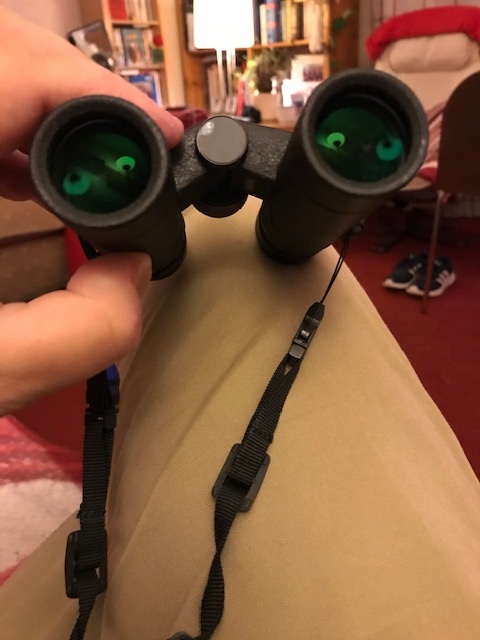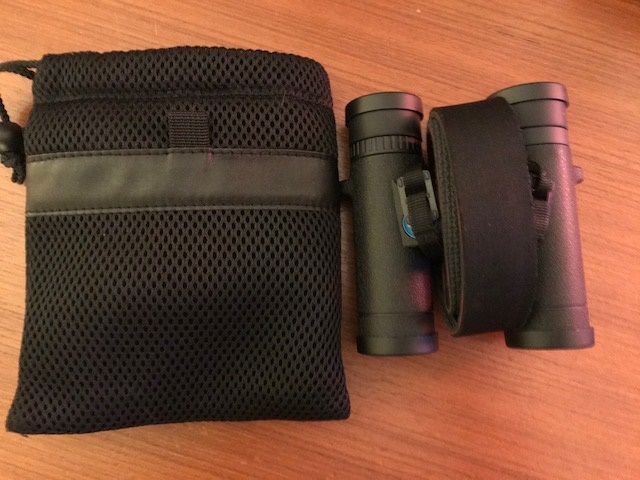
The Viking Optical Ventura 10 x 25 Compact Binocular.
A work begun September 25 2020
Product: Viking Optical Ventura 10 x 25
Weight: 305g
Chassis: Polycarbonate
Coatings: Fully multi-coated, dielectric and phase coated prisms
Field of view: 6.5 angular degrees(114m @1000m)
Eye Relief: 13mm
Eye cups: Twist up
Close focus: 4m
Tripod compatible: Yes
Waterproof: Yes
Nitrogen Purged: Yes; 1 metre for 5 mins.
Warranty: 10 years
Dimensions: 11 x 11.5 cm
Supplied Accessories: Carry case, neck strap, lens caps
Retail Price: £120-145 UK
Viking Optical is a UK-based company that has recently brought a good range of their own branded binoculars to market. In past blogs, I have favourably reviewed two of their models, the Viking Kestrel ED 8 x 42 and Merlin ED 8 x 32, which offer excellent value for money, with their very good optics and mechanics. Having developed rather a soft-spot for pocket binoculars in general, I was curious to find out how their smaller glasses would fare, and so I ordered up Viking’s Ventura 10 x 25 for evaluation. What follows is arguably the first review of this model I have seen on the internet.
The Ventura pocket binocular arrived in perfect nick, double-boxed and containing all the promised accessories, which included the 10 x 25 binocular, a soft neoprene pouch, ocular and objective lens caps and a high quality neck strap. First impressions were very good. The instrument felt nice and solid in my hands, with a tough, texturized rubber armouring which is beautifully finished. The metal focuser moved smoothly, both clockwise and anti-clockwise, with no discernible backlash. The twist-up eye cups are of high quality and slide upwards rather than clicking into place. Both cups are overlaid with soft rubber making viewing through them quite comfortable. The right eye dioptre, located just under the ocular lens proved to be very rigid – a bit too rigid for my liking to be completely honest – and my first impressions of the optical performance showed that it delivered nice, sharp, bright images, with a large field of view.

The Viking Optical Ventura 10x 25 showing the fully multi-coated ocular lenses.
Tests for light leaks, internal reflections etc
Setting my iphone torch at its brightest setting, I directed the little Ventura binocular into the intensely bright light beam and examined the images generated. I was relieved to get a very good result – there was a few, minor internal reflections and a modest diffraction spike, but overall the image was very clean and free from diffusion, indicative of the use of high-quality glass components. Overall, it was a notch down from my superlative Leica Trinovid 8 x 32 in this regard, but I was very happy with the result, especially given its moderate price tag. Testing on a bright sodium street light after dark showed very little in the way of internal reflections. This will be a good binocular for observing lit-up scenes in towns, cities or habours, as well as for Moon gazing.

The objective lenses have good anti-reflection coatings but are not very deeply recessed.
Impressions in the bright daylight conditions
I was quite surprised by the size of the field of view on this instrument, especially given its 10x magnification. 6.5 degrees is very wide and indeed, it is larger than the 6.3 degree field offered up by the 8x model. My previous experiences with binoculars delivering impressively wide fields taught me to be cautious about expecting excellent edge-to-edge field performance from a mid-priced model like this. And my tests confirmed by suspicions. Though the binocular has quite a large sweet spot, the image softens noticeably as one moves beyond about 60 per cent of the way from the centre. Indeed the outer 15 per cent or so was very blurred indeed. And while I could correct for much of this edge of field blurring by refocusing, it left the centre of the field out of focus. Testing under the stars showed that it displays quite strong coma, and a touch of barrel distortion near the field stop, with bright stars like Vega transforming from tiny pinpoints in the centre of the field into prominent ‘seagulls’ at the edge. Depth of field too is noticeably shallower than in a high quality 8 x 25 binocular I used as a control in side by side tests. The image is very sharp and bright provided one stays within the sweet spot, so potential buyers should bear this in mind. The binocular displays excellent control of chromatic aberration even though it does not have extra low dispersion glass elements.

The underside of the binocular.
The most annoying result I found with this binocular was its very strong veiling glare. Observing in the open air, under a bright, overcast sky manifested this very strongly indeed. It also shows up when one observes the tops of trees or a hill under a bright background sky. This can be somewhat ameliorated by shading with an outstretched hand but I still couldn’t eliminate all of it. The images were much better if I observed under the shade of a tree or under a roof where the bright overhead sky is blocked off. The effect is also not seen while observing under the shade of forest trees.
Strong veiling glare like this results from the objectives not been deeply recessed enough from the end of the barrel but also from ineffective buffering of reflected light off the lens edges or the space between the lenses. Compared to an Opticron Aspheric LE 8 x 25, which has objectives that are about as deeply recessed as the Viking Ventura, the latter proved to have much stronger veiling glare. This is a problem Viking should look to improve in the future.
The ergonomics of the Ventura binocular are excellent as pocket glasses go. Its long barrels and short central bridge allows one to wrap one’s fingers around the instrument to achieve a very steady viewing posture. Remarkably, the focus wheel requires nearly three full revolutions to go from one focus extreme to the other! It’s quoted close focus of 4 metres is a gross over estimate though, at least on the unit I tested. I measured the 10 x 25 Ventura’s close focus to be more like 2.5 metres.
As stated earlier, the binocular comes with an exceptionally high quality neck strap which is well padded, and, owing to its quick-release clips, can be easily removed. Ditto the soft neoprene case that fits the instrument snugly, even with the strap attached.

The exceptional quality neck strap that accompanies the Viking Ventura 10 x 25.
Conclusions
I have mixed feelings about this binocular. While its mechanical and ergonomic virtues are clearly in evidence, I felt it under-achieved optically. This is especially the case since I have tested similarly priced instruments with better optical performance than the Ventura pocket glass. The designers could have sacrificed some field size for better field correction and this would not have been missed on a binocular this small. 6.5 degrees is relatively enormous for a 10 x 25 glass anyway. The instrument could also benefit from supressing veiling glare more strongly. Personally, I could live with the inferior edge of field performance if the veiling glare issue were better addressed, since its centre of field performance is quite excellent. Together though, these defects represent a deal breaker for me. I do hope that the 8 x 25 Ventura shows less issues than the 10x!

The Viking Optical Ventura 10 x 25 comes with a snugly fitting soft neoprene pouch for easy storage and transport.
Neil English hopes to review many more binoculars in the future in order to build a decent portfolio for a forthcoming book. Thanks for reading.